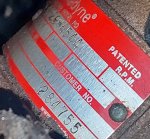Erik Unyielding
Member
- 41
- 64
- 18
- Location
- South Shore, Massachusetts
While I'm waiting for my 700R4 to be ready to swap in, I'm working the bugs out of my m1008 (stock 6.2L Detroit). The previous owner reported that the main fuel filter is new but the inline fuel filter that's been installed before the lift pump might be an issue if I experience power loss. On the 30 minute drive home, everything was great at first and then it seemed like I was getting some power loss. By the time I'd reached home, putting the truck in reverse resulted in a stall. It restarted fine but stalled immediately if I revved the engine and then quickly let off.
My question is, does this sound like a clogged filter or a fuel pressure regulator or injector issue?I don't know much about Detroits so I don't know where the IPR is or how to check it. I've collected the parts to do an electric pump and spin-on filter conversion but I'd like to make sure if it's an IPR or tank vacuum issue or similar that I'm addressing it first.
My question is, does this sound like a clogged filter or a fuel pressure regulator or injector issue?I don't know much about Detroits so I don't know where the IPR is or how to check it. I've collected the parts to do an electric pump and spin-on filter conversion but I'd like to make sure if it's an IPR or tank vacuum issue or similar that I'm addressing it first.




